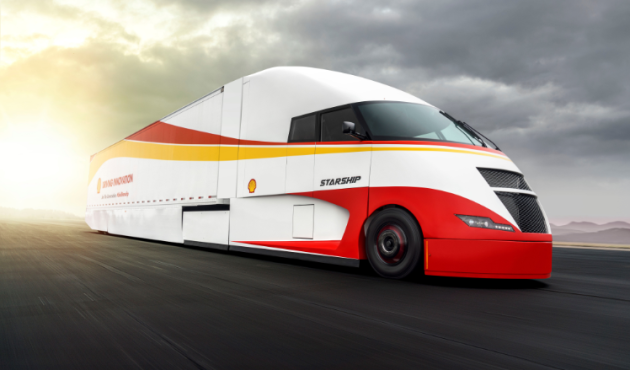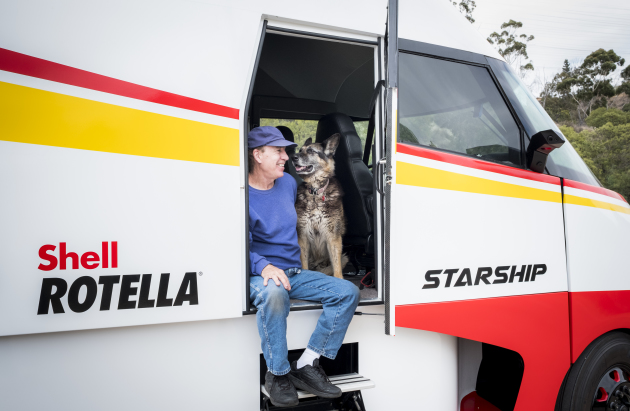Shell’s Starship achieves 178.4 ton-miles per gallon
JACKSONVILLE, Fla. – After a six-day, 2,300-mile journey across the United States, Shell’s Starship lived up to its tagline of being ‘super fuel-efficient’ by putting up major numbers on its run.
The truck, developed collaboratively with Shell Lubricants and AirFlow Truck Company, attained a remarkable 178.4 ton-miles per gallon for freight efficiency – representing a 248% increase over the North American average that sits at 72 ton-miles per gallon today – during its trip from San Diego, Calif. to Jacksonville, Fla. in the last week of May. In total, the Starship burned 257 gallons of fuel.
The freight ton efficiency number is the one to focus on according to Shell executives, as it is a “more relevant statistic for judging the energy intensity associated with moving cargo from point A to point B since it combines the weight of cargo being moved with the amount of fuel consumed.”
By focusing on miles per gallon only, Robert Mainwairing technology manager for innovation, Shell Lubricants, said, you’re making drivers “go slow, and go light. And that encourages truckers to run empty. The better alternative is freight ton efficient, to assess the amount of fuel or energy required…so it drives a go slow, go heavy approach.”
And that’s exactly how the truck got from point A to point B – slow and heavy.
The truck, loaded with clean reef material, weighed in at 73,000 lbs, with an average speed of just over 50 mph, was decked out in a number of aerodynamic improvements and technologies to help achieve these numbers.
“Our goal with the Starship Initiative is to challenge how the trucking industry is defined and to further the conversation by working with AirFlow Truck Company and others,” said Mainwairing. “Through this road trip, we were able to test the Starship truck along with a number of technologies available today to provide insight into what trucking fleets and owner/operators could consider adopting to help reduce fuel use and emissions as they haul heavy loads.”
The cab itself is a bespoke aerodynamic design made of carbon fiber, to minimize wind resistance. The futuristic and streamlined design of the truck was amped up with cameras replacing the side mirrors.
It also sports active grill shutters, that open and close to maximize efficiency. Boat tails also played a major role in the fuel economy the truck achieved.
In addition to having low rolling resistance, single-wide based tires on the truck, it also has an automatic tire inflation system installed.
The roof of the truck is covered with 5,000 watt solar panels that charge the main 48 volt battery bank on the tractor. The battery powers the cab’s air conditioning and inverter for the 120 volt hotel loads.
According to Shell, if all the trucks in the U.S. reached the overall fuel economy and freight ton efficiency as the Starship, they would emit 229 million less tons of CO2 into the atmosphere per year, which would correspond to a 60% reduction in CO2 emission from U.S. truck fleets.
Though all of these technologies helped achieve remarkable number, none could be possible, said Shell, if it wasn’t for operational efficiencies controlled by the driver.
Driving the truck across the country was Robert Sliwa, the owner of AirFlow Truck Company.
“A poor driver can negate all the technology in the truck and get poor fuel mileage,” he said.
Overall, Sliwa reached an average of 8.94 mpg with the Starship on his run. The best fuel economy attained in his trip was 10.2 mpg. He said the truck was extremely quiet, most times he couldn’t even hear the engine on his trip, only the tires. His German shepherd, Kayla, joined him for the six-day trip that concluded on May 24.
“Driving the truck is an exercise in concentration,” he added. “The mental aspect of it is not to be underestimated. I was constantly aware of the grades the truck was coming up to and going down. I was doing my own predictive cruise. Really for a truck driver to maintain the best fuel economy he or she can, you have to get feedback from the gauge and anticipate what is coming up.”

The results of the truck were measured by the North American Council for Freight Efficiency (NACFE) as a third-party.
According to Mike Roeth, the executive director of NACFE, the council used two telematics devices and a data logger to verify the results.
Essentially, Roeth said, NACFE used a PeopleNet device and a LinkeDrive device to measure miles travelled, fuel consumed, and weight.
“The Shell team didn’t take the easy road to trying to achieve the best results they could with their first drive with the truck,” he said. “They knew they wanted to make the truck run, but they went a step further. They carried a much heavier load than many average truckers on the road carry, traveled a longer route in an uncontrolled environment with a variety of technologies not tested in these real-world conditions. For us, it was a rewarding opportunity to see the truck move from an idea on paper to traveling with the team on the road to help verify the run results.”
And while these results are all Shell could have hoped for, Carlos Maurer, Shell Lubricants Americas president, says this is just the tip of the iceberg for what is achievable tomorrow.
“For me, what is fantastic, is that this truck can be commercialized and on the road today,” he said. “All the products and technologies on the truck are ready to be rolled out. I believe the results today are just the baseline and I believe we will get better as time goes on and continue to make improvements.”
Have your say
This is a moderated forum. Comments will no longer be published unless they are accompanied by a first and last name and a verifiable email address. (Today's Trucking will not publish or share the email address.) Profane language and content deemed to be libelous, racist, or threatening in nature will not be published under any circumstances.